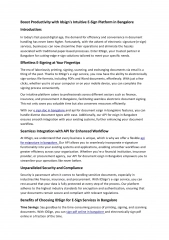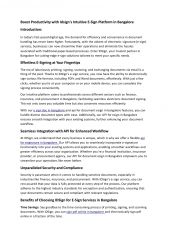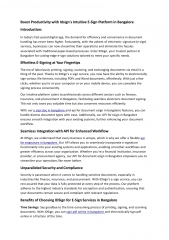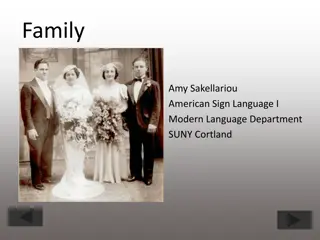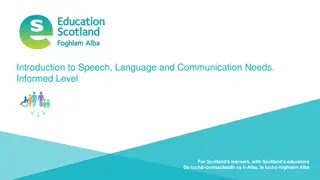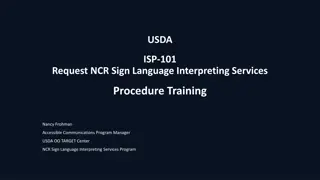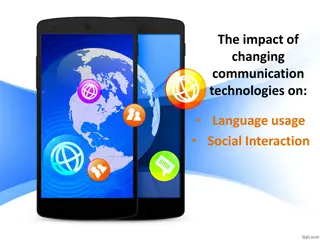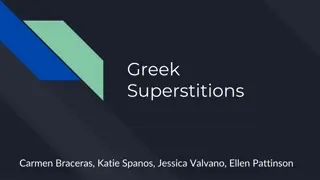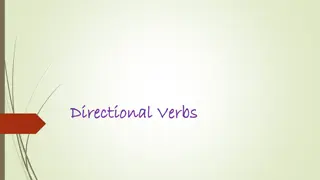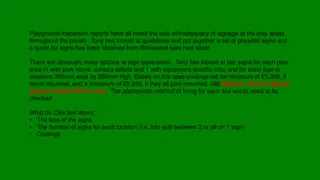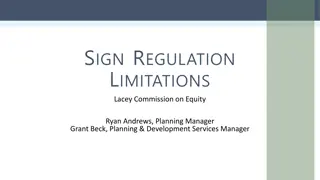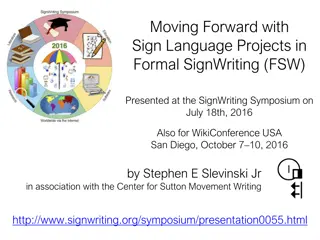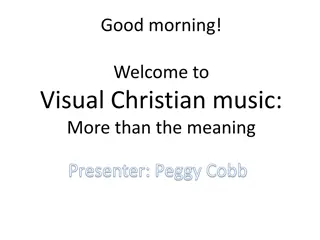Understanding Communication and Sign Language
Communication is the vital process of exchanging information, ideas, and emotions through various channels such as speech, signals, and writing. This includes verbal and non-verbal communication, where sign language plays a crucial role. Effective communication depends on the sender, message, channel, and receiver. Verbal communication involves spoken and written words, while non-verbal communication includes gestures, body language, and facial expressions. Sign language is a form of non-verbal communication that transcends linguistic barriers. Mastering the art of communication enhances understanding and connectivity among individuals.
Download Presentation

Please find below an Image/Link to download the presentation.
The content on the website is provided AS IS for your information and personal use only. It may not be sold, licensed, or shared on other websites without obtaining consent from the author. Download presentation by click this link. If you encounter any issues during the download, it is possible that the publisher has removed the file from their server.
E N D
Presentation Transcript
COMMUNICATION COMMUNICATION AND AND SIGN LANGUAGE SIGN LANGUAGE
Communication is a process of exchanging information, ideas, thoughts, emotions through speech, signals, writing, or behavior. In communication process, a sender send a message by using a medium/channel while the receiver receive the message / information. feelings and
People communicate with each other in a number of ways, which Depends upon: Sender, Message, Channel / Medium (the way we send the info) and the receiver.
Types of communication: Types of communication communication channels used are: the based on Verbal Communication: Non-Verbal Communication:
Verbal Communication Verbal Communication Verbal Communication refers to the form of communication in which message is transmitted verbally; i.e.: The communication is done by word of mouth and a piece of writing. Categories of Verbal Communication: a) Oral Communication (Spoken words are used). b) Written Communication (written material, written signs or symbols are used).
Non Non- -Verbal Communication Verbal Communication Nonverbal communication is the sending or receiving of wordless messages. We can say that communication other than oral and written, such as gesture, body language, tone of voice, Sign Language is called nonverbal communication.
Facial Expressions: Sign Language
Nonverbal following three elements communication have the Appearance Speaker:clothing, hairstyle, etc. Surrounding: room size, lighting, other facilities Body Language: Facial Expressions, Gestures, etc Sounds: Voice Tone / Volume, Speech rate
General Info: A system of manual communication used by the deaf (Hearing Impaired Persons). The signs are conventional movements that represent a range of meanings similar to those expressed by speech, and differing widely between communities.
Sign Language: Sign languages generally do not have any direct relation to the spoken languages of the lands in which they arise. The correlation between sign and spoken languages is complex and varies depending on the country more than the spoken language. Sign Language sometimes borrows elements from spoken languages, just as all languages borrow from other languages that they are in contact with.
Sign Languages, like all natural languages, are developed by the people who use them. The majorities of Deaf people (90%) are born to hearing parents and therefore do not acquire Sign Language as a mother tongue. They acquire Sign Language at school from peers.
History: Groups of deaf people have used sign languages throughout history. As Sign Language has been an essential aspect of communication throughout human history. Since the beginning communication, sign language has changed and grown into the system that people see today. of human
History: Early in human history, humans used simple sign language to express basic ideas. When people were found to be deaf in ancient times, they were often mistreated; therefore, deaf people were not given the chance to work on creating a language. One of the earliest written records of a sign language is from the Fifth Century BC, It was said, "If we had not a voice or a tongue, and wanted to express things to one another, wouldn't we try to make signs by moving our hands, head, and the rest of our body, just as dumb people do at present? Bauman, Dirksen (2008). Open your eyes: Deaf studies talking. University of Minnesota Press. ISBN 0-8166-4619-8.
In 1500's Deaf Education Develops: In 1500, one of the physician from Italy, attempts to teach his deaf son using a code of symbols. And He successfully teaches speech to people deaf since birth. Even they created his own form of sign language to bypass his "vow of silence". This form of sign language may have been then taught to deaf children later on.
In 1620, Juan Pablo wrote a sign language dictionary that outlined how to learn sign language and contained the first sign language alphabet.
1760 French Sign Language Established: In France, the first sign languages developed in the 18th century. Charles Michel De, a French priest, was considered the "Father of Sign Language and Deaf Education" because he established the first free public school for the deaf in Paris, in 1760. His lessons were based upon his observations of deaf people signing with hands in the streets of Paris One day he viewed two deaf sisters communicating with each other in sign language, and realized the deaf could be educated by sign language.
At the same time (i.e.1760), oral educators make walks / march in Spain, Germany, France, Holland and England. In 1788: Charles Michel publishes a dictionary of French Sign Language.
American Sign Language: American Sign Language, or ASL became prominent in the 1800's, by Thomas Hopkins Gallaudet. He wanted to help his neighbor's deaf daughter, So he travelled to Europe to study how to communicate with deaf people. where he met with a deaf instructors of sign language, and the two of them returned to America to found the first school for the deaf. From there they began to teach deaf Americans how to learn sign language and began establishing a unique sign language in the United States. In 1817, Clerc and Gallaudet founded the American Asylum for the Deaf and Dumb (now the American School for the Deaf). In 1864, a college for deaf people was founded in Washington D.C. It was named The National Deaf-Mute College (later "Gallaudet College" (1894), and then renamed "Gallaudet University") in 1986.
In 1839: The first school to integrate deaf and blind students opens. In 1847: American Register of the Deaf first proposes the idea of higher education for the Deaf. 1892 Electrical Hearing Aid Invented: While early hearing aids are not easy to use (most weigh several pounds and must be placed on a desk), the carbon-based microphones, powered by large three-and six-volt batteries, give hearing-impaired people truly amplified sound for the first time. In 1901, The First Electric Hearing Aid (radio aid) is Developed.
1910's-1950's Deaf Employment Skyrockets: During World War I and II the Deaf are not allowed to serve in the U.S. military. Many take manufacturing jobs and new deaf communities flourish. In Europe, the Deaf are allowed to serve. In the field, commands are given using special signs that can be seen at a distance. In 1950, Behind the ear hearing aid becomes available In 1964 Phone for Deaf Invented: Phone for Deaf Invented and the National Technical Institute for the Deaf (NTID) is established. Robert Weitbrecht, who is deaf, invents the teletypewriter (TTY), which enables deaf people to use phone lines to call each other and type out their conversations. Located on the campus of the Rochester Institute of Technology, NTID is the first technological college for deaf students in the world.
1970's Total Communication Leads to Mainstreaming: Total Communication, a combination of manual and speech-based instruction for the Deaf is developed and promoted. The Total Communication system becomes the foundation for a new approach to deaf education within public school systems. In 1997, The World Federation for the Deaf and Blind is founded.
Note: Until the 19th century, most of what we know about historical sign languages was limited to the manual alphabets (fingerspelling systems) that were invented to facilitate transfer of words from a spoken to a signed language, rather than documentation of the rest of the language.
Sign Language is the first language of the majority of deaf children.
In 1500's Deaf Education Develops: The 1500 one of the physician from Geronimo Cardano of Padua, Italy, attempts to teach his deaf son using a code of symbols. And Pedro Ponce de Leon, successfully teaches speech to people deaf since birth. Even they created his own form of sign language to bypass his "vow of silence". This form of sign language may have been then taught to deaf children later on.
In 1620, Juan Pablo Bonet wrote a sign language dictionary that outlined how to learn sign language and contained the first sign language alphabet. His sign language alphabet later communication when the first schools for the deaf were opened. In addition, Martha's Vineyard was an area that was settled by about 200 immigrants who carried dominant and recessive genes for deafness, so the inhabitants came up with their own kind of sign language and taught their descendants how to learn sign language. influenced deaf
1760 French Sign Language Established: In France, the first sign languages developed in the 18th century. Charles Michel De, a French priest, was really considered the "Father of Sign Language and Deaf Education" because he established the first free public school for the deaf in Paris, in 1760. His lessons were based upon his observations of deaf people signing with hands in the streets of Paris One day he viewed two deaf sisters communicating with each other in sign language, and realized the deaf could be educated by sign language. He standardized a sign language alphabet for French language and included this in a sign language dictionary that also included symbolic gestures that conveyed concepts as opposed to just letters.
At the same time (i.e.1760), oral educators make walks / march in Spain, Germany, France, Holland and England. Among the most successful oral teachers of the deaf is Samuel Heinicke, a German educator. Heinicke teaches pupils speech by having them feel his throat while he speaks; his techniques are called "the German Method. In 1788: Charles Michel De L Eppe publishes a dictionary of French Sign Language.
American Sign Language: American Sign Language, or ASL became prominent in the 1800's, by Thomas Hopkins Gallaudet. He wanted to help his neighbor's deaf daughter, So he travelled to Europe to study how to communicate with deaf people. There, he met Laurent Clerc who was a deaf instructor of sign language, and the two of them returned to America to found the first school for the deaf. From there they began to teach deaf Americans how to learn sign language and began establishing a unique sign language in the United States. In 1817, Clerc and Gallaudet founded the American Asylum for the Deaf and Dumb (now the American School for the Deaf). In 1864, a college for deaf people was founded in Washington D.C. It was named The National Deaf-Mute College (later "Gallaudet College" (1894), and then renamed "Gallaudet University") in 1986.


